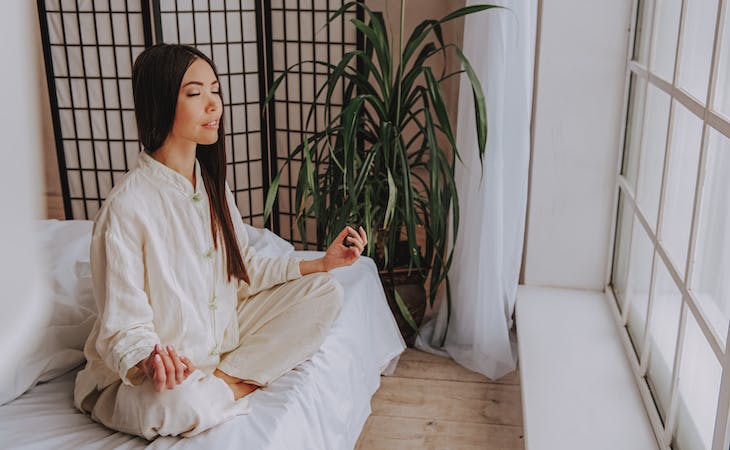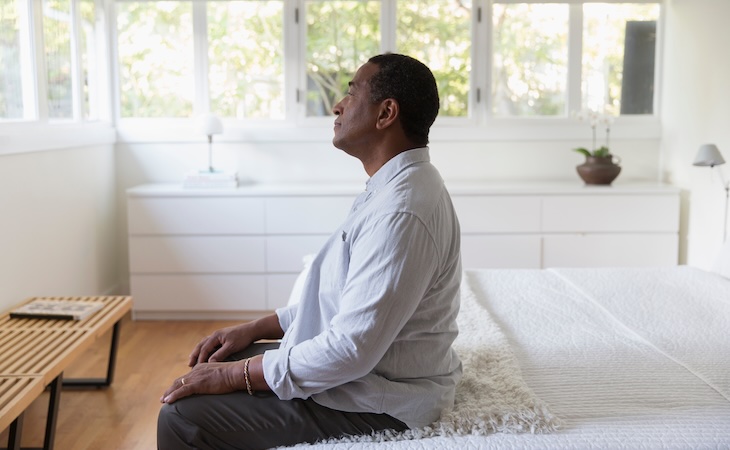Time and time again, research shows meditation has myriad health benefits, including reducing anxiety and making it easier to sleep.
Meditation master Yogmata Keiko Aikawa says meditation calms the mind—and a regular meditation practice can help you feel recharged, energized, and healthy.
Akai Jackson, meditation trainer and CEO of IXL, a personal and professional development agency that curates mindset shift programs, believes the top benefit of meditating is reducing stress.
“Stress disrupts sleep, can stall weight loss, creates anxiety, increases fatigue, and raises blood pressure,” he says. “Stress, whether it’s physical stress on the body or in the mind, can cause major damage in a person’s life—so it’s very evident as to why it’s usually the primary reason people meditate.”
Jackson adds that meditation is something you can do anywhere without any equipment-that means that you can easily meditate in bed, which is very convenient. Meditating from any comfortable place, including your bed, can make you feel a lot more relaxed and allow you to have those precious moments of peace and quiet.
If you’re looking for ways to meditate before sleep, read on for instructions on how to meditate in bed while reaping the many benefits of this practice.
How to meditate while in bed
There are several easy ways to meditate in bed. Our experts share the best methods to de-stress while meditating from the comfort of your bed.
Opt for a seated position
Although you may be tempted to lie down while meditating in bed, Keiko Aikawa says the best way to meditate before sleep is to assume a seated position.
It will bring peace to your mind and body, she says. It’s important to awaken your consciousness. Of course, it’s relaxing, but lying down on a bed might make you fall asleep.
If sitting in bed is feeling a bit uncomfortable, Keiko Aikawa says you can use a cushion on the back of the bed to lean against. The pillow from your bed can work as a cushion.
She adds that the best seated position is sitting cross-legged, which can stabilize your body, keep your spine straight, and prevent you from falling asleep. If sitting cross-legged isn’t feeling ideal, you can choose to sit on a pillow for added comfort.
Get prepared
The steps to achieve an effective meditative state are the same whether you’re in bed or not. Jackson recommends that before you begin, you set a timer between 5 and 30 minutes.
If you’re struggling with remembering to do your daily meditation practice, Keiko Aikawa advises setting a reminder—this could be done on your phone, through a habit-tracking app, or by writing it down in your planner.
She adds that while meditating, it’s a good idea to listen to music, so be sure to switch it on before starting. Quiet and soothing music lets us be in something like a daze, she says. Your nerves will be at ease.
Notice your thoughts and breathe
Meditation is all about not judging your thoughts—so instead of chastising yourself for having a racing mind, give yourself a break, simply notice the thoughts, and let them drift away.
Make sure you know when your mind begins to wander or get away from you, Jackson says. Inevitably, your attention will leave and wander to other places. When you get around to noticing that your mind has wandered—in a few seconds, a minute, five minutes—simply return your attention to your grounded body, your calm environment, and your breathing.
Speaking of breathing, it should be your chief focus while meditating. For this, Jackson advises slowly breathing in through your nose for four seconds, holding your breath for seven seconds, and slowly breathing out through the mouth, relaxing the lips, for eight seconds. Repeat at least three to four times during your practice.
He adds that it’s key to exhale completely so there’s no more air in your lungs. This creates a full exchange and slows down the heartbeat to help breathe calm over the body, he says. (Here’s how to manifest while you sleep.)
Create a tranquil atmosphere
Think of your bedroom as not only your sleeping space but your meditation studio as well. “Make the place where you meditate sacred,” says Keiko Aikawa. She recommends dimmable lights for your bedroom to truly make it a calm environment while meditating.
Additionally, Jackson suggests clearing your bedroom of all clutter to make sure the area is clean. He says you can also bring a serene scent into your space by either lighting candles or using a diffuser with essential oils.
To incorporate elements of nature in your bedroom, place small rocks or houseplants throughout the space, something Jackson explains can bring a sense of relaxation and healing.
While there are no specific rules or a right or wrong way to create a tranquil space, Jackson does have one hard-and-fast rule you should follow: “No electronics, aside from your music player,” he says. “This means no phones, laptops, tablets, etc. From the distracting ping’ of text messages, emails, and phone calls—just say no to phones in your tranquil space.
For even more meditation inspiration, read this roundup of our favorite Peloton meditations for sleep.







